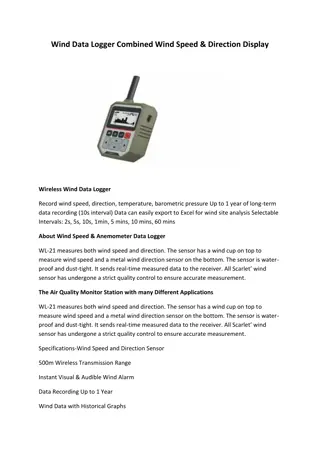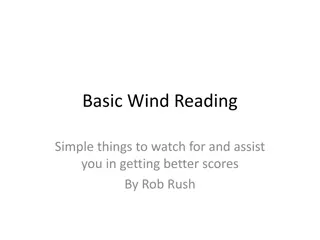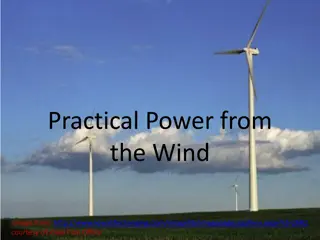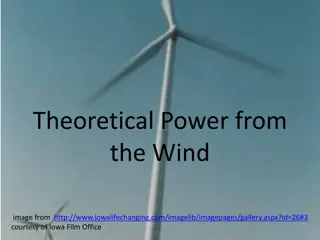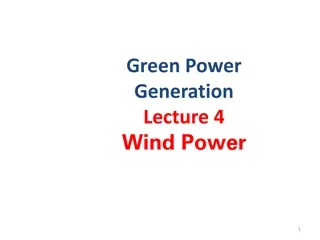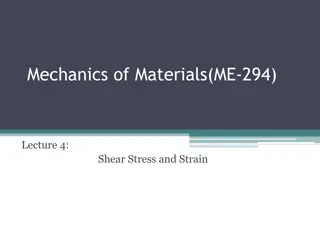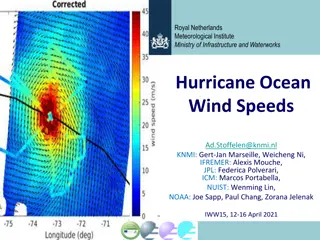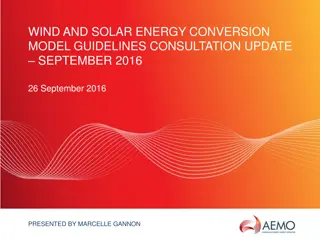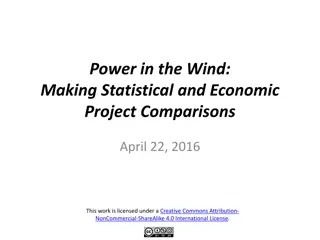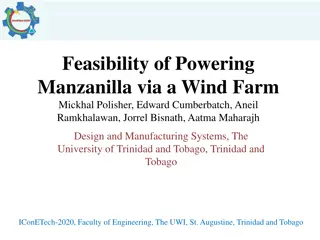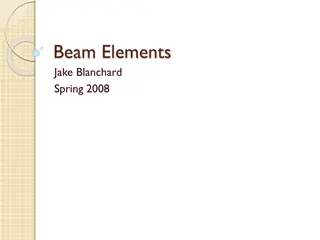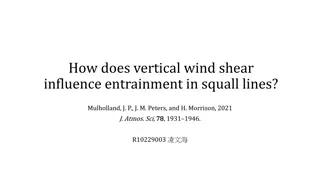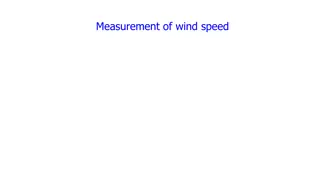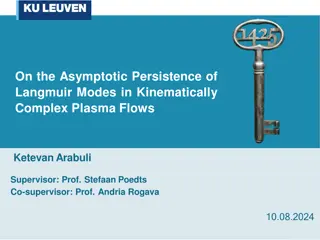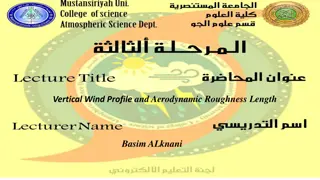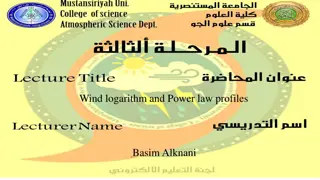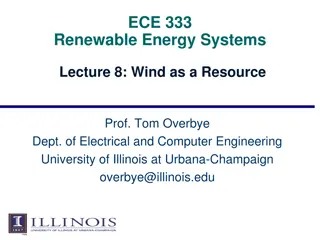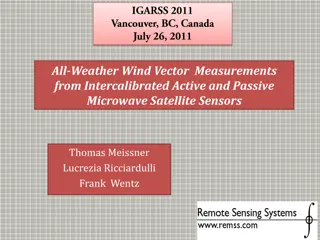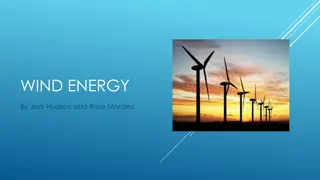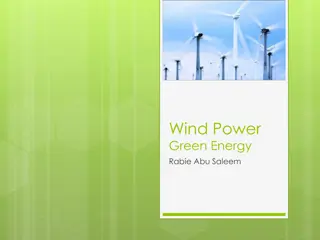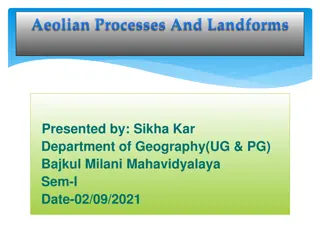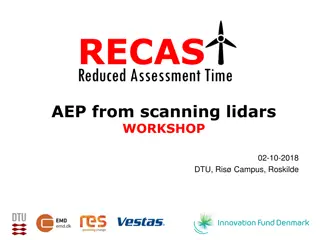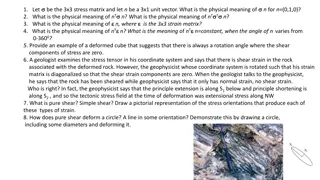Economics of Wind
Discover the economic impact and potential of wind energy in the United States, including job creation, investment opportunities, and the role of wind in powering millions of households. Explore the market drivers, cost reductions, and the role of transmission infrastructure. Learn how embracing win
19 views • 13 slides
Wind Data Logger Combined Wind Speed & Direction Display
\nWireless Wind Data Logger\n\nRecord wind speed, direction, temperature, barometric pressure Up to 1 year of long-term data recording (10s interval) Data can easily export to Excel for wind site analysis Selectable Intervals: 2s, 5s, 10s, 1min, 5 mi
1 views • 2 slides
Exploring Wind Energy: Harnessing Nature's Power for a Sustainable Future
Wind energy, derived from the movement of air masses caused by solar heating, is a clean and renewable energy source. Wind turbines convert this kinetic energy into mechanical energy, offering a range of unit ratings from small to very large. Wind farms, consisting of turbines, generate electricity,
2 views • 19 slides
Wind Reading Essentials for Improved Accuracy in Shooting
Enhance your shooting skills by mastering wind reading basics such as wind speed, wind direction, flag patterns, and their effects on projectiles. Understand how to interpret wind conditions to make accurate shots and improve your scoring. Explore the key factors influencing the flight path of a pro
0 views • 10 slides
Wind Plant Telemetry and Web Services Issues Update
In early January 2023, certain wind plants experienced inaccuracies in their telemetry and web services data, impacting downstream processes. ISO Operating Procedure 14-F outlines requirements for wind plant telemetry, including Real Time High Operating Limit (RTHOL), Wind Plant Future Availability
0 views • 10 slides
Analysis of "Ode to the West Wind" by Percy Bysshe Shelley
Explore the imagery and symbolism in Percy Bysshe Shelley's "Ode to the West Wind." This romantic poem delves into themes of nature, change, and the power of the wind, captivating readers with its profound musings. Delve into the stanzas that illustrate the wind's dual role as both a destroyer and p
1 views • 10 slides
Commercial Wind Energy Basics
This content discusses the fundamental aspects of commercial wind energy, covering topics such as different types of wind turbines, their components, operational principles, and environmental considerations. It explores the distinction between Horizontal-axis wind turbines (HAWT) and Vertical-axis w
0 views • 16 slides
Advancements in New Jersey's Offshore Wind Energy Development
New Jersey has taken significant steps in the development of offshore wind energy, starting as early as 2007. Despite some initial setbacks, progress has been made with initiatives such as the Energy Master Plan and the signing of the Offshore Wind Economic Development Act. Governor Murphy's Executi
0 views • 5 slides
Insights into Wind Power Efficiency and Practical Applications
Exploring the practical and theoretical aspects of wind power, including the Betz Factor and Clipper Wind's actual power curve. Understanding how wind speed affects power output and the limitations of wind turbines in harnessing energy effectively.
0 views • 11 slides
Understanding Wind Power Generation Principles
Exploring the fundamental concepts of wind power generation, this content discusses the relationship between kinetic energy, air mass, and wind energy. It delves into the calculation of wind power using air density, velocity, and swept area, providing insights into how wind power efficiency varies w
0 views • 10 slides
Understanding Wind Power Generation and Wind Farms
Wind power generation involves the use of wind turbines to produce electric power, often in the form of wind farms consisting of multiple turbines. Factors such as wind speed, turbine siting, and altitude play crucial roles in maximizing power production. Wind farms can be located onshore or offshor
1 views • 60 slides
East Bay Community Energy Local Development Business Plan Wind Siting Survey Overview
The East Bay Community Energy's Wind Siting Survey conducted in November 2017 aimed to identify properties in Alameda County suitable for wind energy development. The survey assessed wind speed, hosting potential, and capacity factors, resulting in 110 MW capacity distributed across public and agric
0 views • 6 slides
Symbolism of the Wind in Shelley's "Ode to the West Wind
Elemental phenomena, like the wind, symbolize the spirit of the Romantic age in Shelley's "Ode to the West Wind." The poem portrays the west wind as a powerful force of nature, associated with freedom, inspiration, and the Holy Spirit. Through vivid imagery, Shelley explores the transformative and r
0 views • 7 slides
The Influence of the West Wind on Nature: A Visual Journey
The poetic verses of "Ode to the West Wind" by Percy Bysshe Shelley vividly depict the disruptive and transformative impact of the West Wind on nature. Through captivating imagery, the poem portrays how the West Wind stirs the Mediterranean sea from its slumber, creates chasms in the Atlantic Ocean,
1 views • 20 slides
Understanding Shear Stress in Mechanics of Materials
Shear stress is a critical concept in Mechanics of Materials, describing the stress parallel to a surface due to applied forces. This stress is crucial in various applications like metal joints, punching operations, and more. Shear stress calculations can help engineers determine the strength and du
0 views • 19 slides
Challenges in Hurricane Wind Speed Calibration and Validation Metrics
Need for accurate extreme wind measurements is crucial for various applications like hurricane tracking, climate monitoring, and oceanography. This includes reliance on dropsondes for wind speed calibration, validation metrics using multiple methods, and challenges in integrating different sources o
0 views • 22 slides
Optimal Wind Farm Control Framework for Real Wind Farms
This research focuses on developing a framework for a multi-objective wind farm controller applicable to real wind farms. It addresses the significant power loss and increased fatigue loads caused by wake effects in wind farms. The objectives include composing solutions into a control framework, ide
0 views • 12 slides
NOAA SAR High-Resolution Coastal Winds Overview
NOAA's Operational SAR Sea Surface Wind Products provide detailed information on wind patterns derived from SAR images. The system aims to implement high-resolution wind production, capable of deriving winds from various SAR satellites. The operational goals include compatibility with international
0 views • 28 slides
Wind and Solar Energy Conversion Model Guidelines Consultation Update September 2016
Presented by Marcelle Gannon, this update covers the status of the consultation process, local limit and wind speed changes, extreme wind cut-out, possible power, estimated power proposal, and next steps. It provides insights into the current status of the consultation process, issues paper, draft r
0 views • 13 slides
Exploring Wind Power: Statistical and Economic Project Comparisons
Delve into the world of wind power with this informative content covering the origins of wind, effects of Earth's rotation on wind patterns, and the impact of elevation on wind speed. Learn about the calculations and units involved in wind energy analysis, providing a comprehensive overview of this
0 views • 32 slides
Experimental Study on Wind Shear Effects on Laser Propagation
Research conducted by Joe Watkins, Reza Malek-Madani, and Svetlana Avramov-Zamurovic to analyze the impact of wind shear on laser propagation. The experiments involved a HeNe red laser passing through a tunnel with varying wind speeds. Data on light intensities and wind influence were collected and
0 views • 7 slides
Feasibility Study: Powering Manzanilla with a Wind Farm
A feasibility study by Mickhal Polisher and team from The University of Trinidad and Tobago explores the potential of powering the area of Manzanilla with a wind farm. The study aims to determine the power consumption of the area, assess the use of wind resources to meet demand, and evaluate the via
0 views • 19 slides
Understanding Beam Elements and Shear Effects in Structural Analysis
Beam elements play a crucial role in structural analysis, offering insights into line elements with various degrees of freedom for bending modes and stress analysis. Shear deflection and stresses in beams are essential considerations when accounting for shear effects. Learn about real constants, sha
0 views • 16 slides
Understanding Shear and Moment in Beams
Beams play a crucial role in mechanical engineering, with two main types - statically determinate and indeterminate beams. Explore the definition of beams, loading types, and the concept of shear and moment diagrams to understand the behavior of beams under different loads and reactions. Learn how t
0 views • 8 slides
Cosmic Shear Measurement in Fourier Space and Its Scientific Goals
Exploring the cosmic shear in Fourier space with a collaborative effort led by Jun Zhang from Shanghai Jiao Tong University sheds light on fundamental scientific questions related to dark energy, the geometry of the universe, General Relativity, cold dark matter, and cosmic structure density distrib
0 views • 48 slides
Influence of Vertical Wind Shear on Entrainment in Squall Lines
The strength and direction of low-level (LL) and upper-level (UL) wind shear influence the properties of squall line updrafts, with stronger shear environments fostering wider updrafts that are less susceptible to entrainment-driven dilution. The relative influences of LL and UL shear on this relati
0 views • 40 slides
Wind Measurement and Observation Techniques
Wind speed and direction are crucial parameters in meteorology. This article explores the measurement of wind speed using a Cup Counter Anemometer and the procedures for recording wind observations. It also delves into the methods for measuring wind direction. Understanding these techniques is essen
0 views • 16 slides
Persistence of Langmuir Modes in Complex Shear Flows
Exploring the persistence of Langmuir modes in kinematically complex plasma flows with a focus on shear flows in nature and historical backgrounds. The research delves into the methodology of classical theory and introduces the nonmodal approach to address limitations. Details on shear flow definiti
0 views • 16 slides
Understanding Vertical Wind Profiles and Aerodynamic Roughness Length
The interaction between wind and the Earth's surface affects wind profiles and aerodynamic roughness length. The nature of airflow over surfaces, changes in wind speed with height, and the concept of aerodynamic roughness length are explained. Techniques for estimating aerodynamic roughness length b
0 views • 8 slides
Understanding Wind Profiles and Aerodynamic Roughness Length
Wind profiles are crucial in understanding how wind speed changes with height in the boundary layer. The logarithmic and power law profiles depict this relationship, influenced by surface characteristics and obstacles. The aerodynamic roughness length, defining where wind speed becomes zero, remains
0 views • 14 slides
Understanding Wind Power Generation: Key Concepts and Calculations
Exploring wind power generation concepts, this content delves into the physics behind harnessing wind energy, calculating power in the wind, understanding the impact of wind speed on power generation, and correlating wind turbine size with efficiency and cost-effectiveness. Key equations and example
0 views • 28 slides
Analysis of All-Weather Wind Vector Measurements from Satellite Sensors
This study compares passive (radiometer) and active (scatterometer) microwave satellite sensors in measuring all-weather wind vector speeds. Challenges such as high wind speeds and wind speeds in rain are discussed along with the crucial role of the Ocean Surface Emissivity Model in the retrieval al
0 views • 22 slides
Understanding Extreme Wind Speed Measurements from NASA's SMAP L-Band Radiometer
NASA's SMAP (Soil Moisture Active Passive) mission has been collecting data on extreme wind speeds since April 2015 using an L-band radiometer. The measurements provide valuable insights into wind speed frequencies, with a wide range of signals received by the sensor challenging the data analysis. A
0 views • 17 slides
Describing Rheological Properties of Unknown Materials - In-Class Activity (Spring 2015)
Explore the rheological properties of unknown materials in a hands-on in-class activity. Students work in teams to identify whether samples are pseudoplastic, Newtonian, or dilatant fluids based on viscosity changes with shear rate. Corn syrup, corn starch, icing, and toothpaste are analyzed, with f
0 views • 5 slides
Exploring Wind Energy: Turbines, Costs, and Innovations
Delve into the world of wind energy with insights on how wind turbines work, their uses in different settings, innovative turbine designs, and the costs associated with wind energy production. Learn about the environmental and economic aspects of industrial wind turbines, the future visions for wind
0 views • 10 slides
Understanding Wind Power: Historical Development, Turbines, and Statistics
Explore the historical development and statistics of wind power, from the first wind turbine in 1891 to the global capacity growth. Learn about the types of wind turbines - Vertical Axis and Horizontal Axis, their advantages and disadvantages, and various wind turbine models. Discover how wind power
0 views • 28 slides
Understanding Aeolian Processes and Landforms
Aeolian processes are crucial in arid and semi-arid regions, involving erosion, transportation, and deposition by wind. Factors like wind velocity, grain size, rock composition, and vegetation influence erosion. Different types of wind erosion include deflation, abrasion, and attrition. The transpor
0 views • 18 slides
Understanding Shear Strength in Engineering Materials
Shear strength is a crucial mechanical property that defines a material's ability to resist forces causing internal structure to slide. This property plays a significant role in various engineering fields, impacting design, construction, and material selection. Shear strength is essential in prevent
0 views • 31 slides
Advantages of Scanning Lidars in Wind Resource Assessment
Scanning lidars offer a cost-effective and flexible solution for wind resource assessment compared to traditional met masts. They provide multi-point measurements without the need to relocate hardware, reducing uncertainties and risks in wind energy projects. This technology enhances the accuracy of
0 views • 10 slides
Understanding Strain and Stress: Concepts and Applications for Geologists and Geophysicists
This content delves into various aspects of stress and strain in the context of geology and geophysics, exploring the physical meanings of unit vectors, stress matrices, strain matrices, pure shear, simple shear, and their implications on deformation characteristics. It also discusses scenarios wher
0 views • 4 slides

